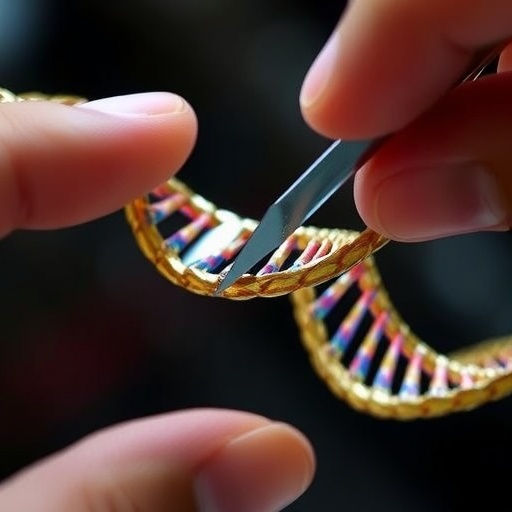In a groundbreaking discovery, a research team from the Institut national de la recherche scientifique (INRS) has unveiled a new family of enzymes capable of inducing precise cuts in single-stranded DNA. This innovation stands as a milestone in genetic engineering, augmenting our arsenal of tools for manipulating genetic material. Professor Frédéric Veyrier and his dedicated team have developed a genetic tool utilizing this new class of enzymes, termed Ssn, which have the unique ability to target and cleave single-stranded DNA with specificity.
Single-stranded DNA, while less prevalent than its double-stranded counterpart, plays a pivotal role in various biological functions and technologies. Found frequently in certain viruses, this form of DNA is integral to processes such as cell replication, repair, and has applications in sequencing, molecular diagnostics, and even nanotechnology. However, the existing limitations of tools focusing on single-stranded DNA have posed significant challenges for researchers aiming to exploit its full potential. Until now, a lack of endonucleases—enzymes that cut DNA—that exclusively target single-stranded sequences has hindered advancements in this area.
The Ssn endonucleases investigated by Veyrier’s team represent a substantial leap forward. By isolating and characterizing these enzymes from the bacterium Neisseria meningitidis, commonly known for its role in bacterial meningitis, the researchers noted that these endonucleases identify specific sequences within single-stranded DNA. The ability to recognize and cut at precise points not only opens new avenues for biological research but also addresses a critical gap in genetic engineering capabilities.
The specificity of the Ssn enzymes is particularly noteworthy. In the bacterium studied, it was found that the enzyme identifies a particular sequence essential for the exchange and modification of genetic material. This molecular recognition mechanism is crucial for driving evolutionary processes and enhancing genetic diversity within microbial populations. As Professor Veyrier articulates, the implications of such discoveries resonate beyond fundamental biology; they provide vital insights into bacterial evolution and adaptation.
Moreover, this research has unearthed thousands of analogous enzymes within this newly identified family. The breadth of the Ssn enzyme family emphasizes how many organisms may possess similar capabilities to manipulate their genetic material. The implications for biotechnology are vast; with the knowledge that such enzymes are widespread, scientists can begin to harness these tools for varying applications across medicine and agriculture.
From a medical standpoint, the potential benefits of these new enzymes could be transformative. By enabling more precise genetic manipulations, researchers could enhance current gene editing technologies, leading to breakthroughs in treating both acquired and hereditary diseases. The prospect of developing refined tools for DNA detection and molecular diagnosis could significantly improve our ability to identify and understand diseases at the genetic level.
The Ssn endonucleases can also contribute to the detection and manipulation of DNA in a multitude of contexts. This could include identifying pathogens in clinical settings, which is critical for the timely treatment of infections. The enhanced accuracy and efficiency afforded by these enzymes may improve diagnostics, offering quicker and more reliable results when it comes to understanding genetic diseases or infections.
Furthermore, the versatility of these enzymes extends to industrial biotechnology, where they could be employed in various applications, including bioengineering and synthetic biology. As we delve deeper into the understanding of genetic systems, tools like the Ssn endonucleases could facilitate innovation across different fields, from sustainable agriculture to pharmacy.
The study surrounding these Ssn enzymes and their capabilities has already made waves in the scientific community, receiving publication in a reputable journal, Nature Communications. This recognition not only underscores the significance of the findings but also encourages further exploration into how such enzymes can be integrated into existing technologies and what other functionalities they may possess.
In conclusion, the identification of this new family of Ssn endonucleases capable of targeting single-stranded DNA marks a pivotal moment in the trajectory of genetic manipulation. These enzymes could redefine many aspects of biotechnology, enhancing current methodologies in gene editing and diagnostics, while also paving the way for future innovations. The research spearheaded by Professor Veyrier and his team suggests that we are just scratching the surface of what is possible within the realm of genetic engineering, and it is an exciting time for scientists eager to explore these new frontiers.
This breakthrough discovery exemplifies how persistent research in microbial genetics can yield technologies with wide-ranging implications, reminding us how much we still have to learn about the fundamental principles that govern life at the molecular level.
Subject of Research:
Article Title: New tool for cutting DNA: promising prospects for biotechnology
News Publication Date: 14-Apr-2025
Web References: Nature Communications
References: Chenal, M., Rivera-Millot, A., Harrison, L.B. et al. Discovery of the widespread site-specific single-stranded nuclease family Ssn. Nat Commun 16, 2388 (2025). DOI link
Image Credits: Ella Maru Studio
Keywords
CRISPR, Ssn endonucleases, single-stranded DNA, gene editing, biotechnology, Neisseria meningitidis, molecular diagnostics, genetic manipulation, evolutionary biology.
Tags: applications of single-stranded DNAbiotechnology breakthroughDNA cutting toolsenzymatic tools in geneticsgenetic engineering advancementsgenetic material manipulationInstitut national de la recherche scientifiquemolecular diagnostics innovationsNeisseria meningitidis researchprecision gene editingsingle-stranded DNA enzymesSsn endonucleases discovery





